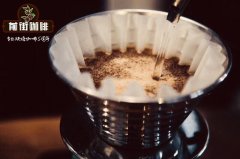Arabica coffee beans are black coffee beans.

Professional coffee knowledge exchange more coffee bean information please follow the coffee workshop (Wechat official account cafe_style)
Qianjie-introduction of three major coffee bean varieties
Arabica- Arabica
Arabica has excellent flavor, but its yield is low and it is not resistant to diseases and insect pests. It has high requirements for climate, soil and other planting conditions. General boutique coffee is Arabica.
Arabica originated in the Ethiopian plateau and was introduced into Europe through the Arab region in the 16th century. Arabica coffee accounts for 75% and 80% of all coffee. Its excellent aroma makes it a coffee variety loved by people all over the world. The world-famous Blue Mountain Coffee and Mocha Coffee are almost all Arabica coffee. This variety of coffee beans are not resistant to diseases and insect pests, the premise of development is relatively harsh, but the taste and caffeine content are better than Robusta.
Robusta- Robusta
The flavor of Robusta is not as good as that of Arabica, but it has high yield, fast growth, good resistance to diseases and insect pests, and the planting requirement is not as high as Arabica, so it is often used as commercial beans.
The hot and humid zone that is not suitable for the growth of Arabica coffee is the place where Robusta coffee grows. Robusta has a unique aroma and bitter taste, accounting for only 2%-3% of the mixed coffee, and the whole cup of coffee becomes Robusta flavor, so its flavor is particularly distinct.
It is generally used in industrial coffee, such as instant coffee, bottled coffee and liquid coffee, with a caffeine content of about 3.2 per cent, much higher than 1.5 per cent of Arabica. The main producing countries are Indonesia, Vietnam and West Africa centered on C ô te d'Ivoire, Algeria and Angola.
Liberica- Liberia
Liberica, that is, large-grained species, originated in Liberia in Africa, and a few countries such as Malaysia, has a strong ability to adapt to high or low temperature, humidity or dryness, and its flavor is worse than that of Arabica species, so it is only traded in some West African countries (Libya, C ô te d'Ivoire, etc.), or planted for research.
Many friends who have just come into contact with coffee do not know what black coffee is. In fact, it is pure coffee. Those who do not add any seasoning are called black coffee.
Knowledge: high-altitude planting areas are all 4000 to 6000 feet above sea level. The planting temperature needs a temperature climate between 15 degrees and 25 degrees, and the annual rainfall must reach 1500 mm to 2000 mm. At the same time, the rainfall time should be in line with the flowering cycle of coffee trees.
In short: Qianjie is a coffee research hall, happy to share the knowledge about coffee with you, we share unreservedly just to make more friends fall in love with coffee, and there will be three low-discount coffee activities every month. The reason is that Qianjie wants to make more friends drink the best coffee at the lowest price, which has been Qianjie's tenet for 6 years!
END
Important Notice :
前街咖啡 FrontStreet Coffee has moved to new addredd:
FrontStreet Coffee Address: 315,Donghua East Road,GuangZhou
Tel:020 38364473
- Prev

Which three types of coffee beans include Arabica coffee beans with rich aroma and high acid quality
Professional coffee knowledge exchange more coffee bean information please follow the coffee workshop (Wechat official account cafe_style) front street-coffee bean variety introduction Arabica species account for about 70% of the world's coffee production, the vast majority of coffee beans that we become raw beans in daily life are Arabica varieties. Because Arabica coffee has a charming aroma and rich flavor
- Next

There are several kinds of coffee beans. Do you understand the characteristics of Arabica coffee beans?
Professional coffee knowledge exchange more coffee bean information please follow the coffee workshop (Wechat official account cafe_style) front street-three major coffee bean varieties introduction Arabica originated in Ethiopia, scientific name Coffea?arabica?Linnaeus. Arabica beans are also called small seeds because of their small fruits and kernels. It is a self-pollinated crop with relatively cold and drought tolerance.
Related
- Beginners will see the "Coffee pull flower" guide!
- What is the difference between ice blog purified milk and ordinary milk coffee?
- Why is the Philippines the largest producer of crops in Liberia?
- For coffee extraction, should the fine powder be retained?
- How does extracted espresso fill pressed powder? How much strength does it take to press the powder?
- How to make jasmine cold extract coffee? Is the jasmine + latte good?
- Will this little toy really make the coffee taste better? How does Lily Drip affect coffee extraction?
- Will the action of slapping the filter cup also affect coffee extraction?
- What's the difference between powder-to-water ratio and powder-to-liquid ratio?
- What is the Ethiopian local species? What does it have to do with Heirloom native species?

